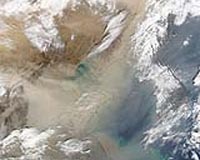| . |  |
. |
New Delhi (AFP) Nov 9, 2009 India blocked a former US naval ship heading for a scrap yard on its west coast, citing environmental and pollution concerns in a case that mirrors past scandals, a local official said Monday. The Platinum II, anchored off the western Gujarat coast, was ordered to remain at sea last month pending a probe by the environment ministry after protests by campaign groups. The case follows other high-profile "toxic ship" cases when vessels heading for India's giant Alang breaking yard in the state of Gujarat have caused controversy. A statement from India's environment ministry obtained by AFP said that "granting permission for beaching and breaking purposes of the ship will not be advisable." "In view of the environment ministry statement, the ship cannot be broken up here," G.V. Patel, head of Gujarat's pollution control board, told AFP. The government's expert panel which probed the contents of the ship said it had found about 238 tonnes of asbestos-containing material, 126 used lead batteries and no radioactive material. The amount of polychlorinated biphenyls or PCBs could not be ascertained due to technical reasons, it added. But Gopal Krishna, head of an environmental lobby group said the 682-foot (207-metre) long ship "contains an estimated 210 tons of PCBs" -- harmful chemicals used in wiring and paint which have been banned in the United States. He described Monday's statement as an "exemplary precedent" and "an order to send the ship back because fraudulent documents were produced" to aid its dismantling in India. The private owners of the Platinum II, previously known as SS Independence during its use in the navy, had agreed to pay a fine of 518,500 dollars in January this year, according to the website of the US Environmental Protection Agency. In 2008, EPA had pursued them over the alleged illegal export of the ship, then called MV Oceanic, for disposal because of the PCBs on board. Exporting PCBs is a violation of US law unless authorised by the EPA. "The ministry has very rightly taken cognisance of the US Environment Protection Agency order and the Gujarat Maritime Board will have no option to send the ship back," Krishna said. The ministry statement has put India's ship-breaking industry back in the spotlight following a previous scandal over the French warship Le Clemenceau. The asbestos-laden French aircraft carrier was turned away from the Alang yard, the world's biggest such facility, in 2006 because of concerns it would endanger the lives of scrapyard workers. The controversy over the Platinum II also mirrors another surrounding former French cruise liner, the Blue Lady, two years ago. Environmentalists had battled lawyers in India's Supreme Court for months pleading it be turned back as the ship was lined with an estimated 1,200 tonnes of cancer-causing materials. But the Blue Lady was taken apart in Alang, 200 kilometres (160 miles) northwest of India's financial centre Mumbai, following a ruling from the court. Share This Article With Planet Earth
Related Links Our Polluted World and Cleaning It Up
 SKorea to plant trees in China to reduce 'yellow dust'
SKorea to plant trees in China to reduce 'yellow dust'Seoul (AFP) Nov 4, 2009 The Seoul city government will help fund a tree-planting project in a Chinese desert to reduce the amount of harmful "yellow dust" blowing over South Korea, officials said Wednesday. The city government signed an accord Tuesday to invest 50 million won (42,000 dollars) in the planting project led by Future Forest, a South Korean environmental group operating in China for the past 10 years. ... read more |
|
| The content herein, unless otherwise known to be public domain, are Copyright 1995-2009 - SpaceDaily. AFP and UPI Wire Stories are copyright Agence France-Presse and United Press International. ESA Portal Reports are copyright European Space Agency. All NASA sourced material is public domain. Additional copyrights may apply in whole or part to other bona fide parties. Advertising does not imply endorsement,agreement or approval of any opinions, statements or information provided by SpaceDaily on any Web page published or hosted by SpaceDaily. Privacy Statement |